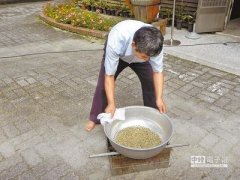Coca-Cola can't sell coffee without one.
Although Coke sells coffee, this tiny spark cannot be the "butterfly" that incites great changes in the beverage market, but it will also bring a gust of wind to the giants in the carbonated drinks industry. Whether it will be a tornado or a gentle breeze will be determined by consumers' preferences and preferences.
one
Go back to the coffee road and make it tailored this time.
Coca-Cola, which once abandoned the ready-to-drink coffee market in mainland China, killed Huima and brought its Joya Coffee to the mainland market. According to Coca-Cola, as one of its 17 brands with annual sales of more than US $1 billion, Qiaoya has been in Seoul, Hong Kong, Tokyo and other markets for many years, and began to list in mainland China at the end of September. Guangzhou, Foshan, Fanshun, Huacong and Shaoguan are all listed in Guangdong Province. According to Coca-Cola's wishes, Qiaoya is mainly aimed at middle-income young white-collar workers. They believe that emerging white-collar workers and urban population communities need a greater variety of beverage choices.
Nine years ago, the carbonated beverage giant was involved in the ready-to-drink coffee business, when its partner was Nestl é. In 2001, Nestl é and Coca-Cola established a joint venture "Global Beverage Partnership" (BPW), each holding 50% of the shares. Coca-Cola is mainly responsible for distribution and production, and Nestl é is responsible for product design, research and development and brand support. In 2005, two major beverage companies joined hands to enter the ready-to-drink coffee market.
However, consumers did not even see the product, and the two partners chose to break up in 2006. However, this "marriage", which ends in separate ways, is regarded by the industry as a "lost horse" experience: understanding the preferences of domestic consumers and mastering sales channel resources have laid the foundation for the giant's comeback.
Indeed, this time Coca-Cola is prepared, according to Coca-Cola: the two flavors on the market are tailor-made for Chinese consumers. Consumer test results show that the "Luzhou-flavor classic" taste has a significant advantage in terms of overall preference and purchase intention. Among the mainstream milk flavors in today's market, "mellow latte" has a higher preference.
two
The small volume market is growing by 30% a year.
Ready-to-drink coffee can win the attention of the beverage giant Coca-Cola, which is enough to see its development prospects in China, according to Xiang Jianjun, a food industry researcher who is a consultant to CIC.
From 2009 to 2013, the compound growth rate of ready-to-drink coffee in China reached 34.2%. Compared with this growth rate, Xiang Jianjun analyzed that it was mainly due to the gradual cultivation of the domestic coffee market, as well as the increase in the number of returnees and overseas travelers. At present, the participants in the domestic ready-to-drink coffee market are Nestl é, Starbucks, Unification, Brown, Master Kang, Kirin and so on. In particular, Nestl é and Unification confessed to Jianjun that these two brands have developed in the domestic ready-to-drink coffee field for many years and have a high market share and a good market foundation.
In addition, "high price and small quantity" has become an embarrassment for the ready-to-drink coffee market. Zhu Danpeng, a researcher at the China Academy of Food Commerce, once publicly told the media that although the overall sales volume of ready-to-drink coffee has maintained an annual growth rate of more than 30%, it accounts for less than 2% of the beverage industry as a whole.
Important Notice :
前街咖啡 FrontStreet Coffee has moved to new addredd:
FrontStreet Coffee Address: 315,Donghua East Road,GuangZhou
Tel:020 38364473
- Prev

The old flavor of baking in the ancient way of Taiwan Coffee Festival
Chinanews.com, Oct. 28-according to a report by Taiwan's "China Times", the coffee roaster is now novel and perfect, but it has an ancient taste of coffee. There have been great changes in the Taiwan Coffee Festival Baking Competition this year, with contestants providing their own roasting machines. some old coffee makers have put up large iron pots, washbasins and charcoal stoves that have been sealed for a long time, ready to bake out the old smell of the Japanese occupation period. Taiwan Coffee Festival starts on November 1st
- Next

International Coffee Competition enters the National Animation Garden
The 2015 World Philharmonic Coffee Competition Tianjin District tryouts were held at the Zhongxin Tianjin Eco-City National Animation Park a few days ago, which is also the first international coffee competition held in Binhai New area. In the end, the two contestants stood out and represented the Tianjin Division in the national finals, competing for the only place to participate in the World Philharmonic Competition in the United States in 2015. Philadelphia is a portable coffee appliance.
Related
- A complete list of coffee bean names and their meanings! What is Yejia Shefi coffee? Where is Mantelin coffee?
- What grade does Arida Manor Kaduai coffee beans belong to? What treatment is Arida ASD slow anaerobic sun exposure?
- The milk tea cup becomes smaller?! Overlord Tea Girl launches a new "Return to Yunnan" series
- Accused of selling counterfeit and high-priced coffee beans! Well-known boutique coffee brand "Oukelao" bowed and apologized!
- How to make espresso dumplings? Can I eat coffee and glutinous rice balls together?
- Save the unformed and stagnant powder cakes in one second! What is the problem with stagnant water in the powder bowl of the espresso machine?
- What does hand-brewed coffee stop mean? Why is it not recommended to make coffee by hand?
- Is it normal to smell like coffee? Why does coffee smell like alcohol? What's wrong with the strong smell of cold extract ice dripping ice brewed coffee?
- How to solve the problem that hand-brewed coffee extraction takes too long? Why is the water flowing so slowly when making coffee?
- The main points of making Australian white coffee, the proportion details, how does Australian white properly foam and blend the flowers?

